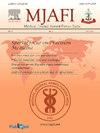Development of a novel multimedia tool for obtaining informed consent from survivors of sexual offenses and its comparison with the conventional method
Q2 Medicine
引用次数: 0
Abstract
Background
Although multimedia tools for obtaining informed consent have been researched for surgeries, chemotherapy, and clinical trials, nothing has been explored in the context of the medico-legal examination of survivors of sexual offenses. The objective of the study was to develop a novel multimedia tool for obtaining informed consent and assent from survivors of sexual offenses and to compare it with conventional consent-taking procedure.
Methods
One cross-sectional study was conducted with survivors of sexual offenses as study participants. They were divided into two groups; one group has been given a conventional consent document, and the other was given an additional multimedia tool. The multimedia tool consisted of one video with animations, audio, and narrations in English and Assamese. Their understanding and satisfaction with the procedures were noted.
Results
Out of the 50 study participants, 46% were children, and the majority fell into the age group of 11–20 years. Only five individuals studied till higher secondary or were still studying. A total of 66% of participants were illiterate or had studied till primary school. However, 86% belonged to lower socioeconomic status. Then, 76% of individuals from the first group consented/assented to medico-legal examination, while all individuals from the second group consented/assented to examination. The second group showed higher levels of understanding (84%) and personal satisfaction (80%).
Conclusion
Multimedia tool for informed consent shows promising results in the field of medico-legal examination. It is survivor friendly, allays fear, and gives a better understanding of the medico-legal examination.
一种新的获得性犯罪幸存者知情同意的多媒体工具的开发及其与传统方法的比较
虽然已经研究了用于手术、化疗和临床试验的获取知情同意的多媒体工具,但在对性犯罪幸存者进行医学法律检查的背景下,还没有进行任何探索。这项研究的目的是开发一种新的多媒体工具,用于获得性犯罪幸存者的知情同意和同意,并将其与传统的同意程序进行比较。方法以性侵幸存者为研究对象进行横断面研究。他们被分为两组;一组获得了传统的同意文件,另一组获得了额外的多媒体工具。多媒体工具包括一个带有动画、音频和英语和阿萨姆语旁白的视频。注意到他们对程序的理解和满意。结果在50名研究参与者中,46%是儿童,大多数年龄在11-20岁之间。只有五个人读到高中或仍在学习。共有66%的参与者是文盲或小学毕业。然而,86%的人属于社会经济地位较低的群体。然后,第一组中76%的人同意/同意进行法医检查,而第二组中所有的人都同意/同意进行检查。第二组表现出更高的理解水平(84%)和个人满意度(80%)。结论多媒体知情同意工具在法医学检验领域具有良好的应用前景。它对幸存者友好,减轻恐惧,并使他们更好地理解法医检查。
本文章由计算机程序翻译,如有差异,请以英文原文为准。
求助全文
约1分钟内获得全文
求助全文
来源期刊

Medical Journal Armed Forces India
Medicine-Medicine (all)
CiteScore
3.40
自引率
0.00%
发文量
206
期刊介绍:
This journal was conceived in 1945 as the Journal of Indian Army Medical Corps. Col DR Thapar was the first Editor who published it on behalf of Lt. Gen Gordon Wilson, the then Director of Medical Services in India. Over the years the journal has achieved various milestones. Presently it is published in Vancouver style, printed on offset, and has a distribution exceeding 5000 per issue. It is published in January, April, July and October each year.
 求助内容:
求助内容: 应助结果提醒方式:
应助结果提醒方式:


